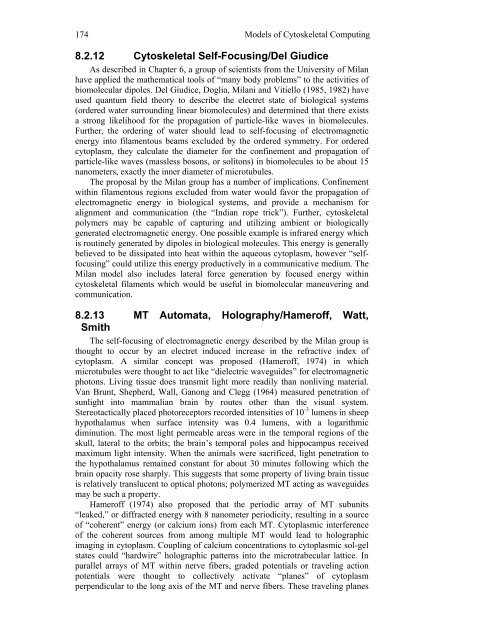ULTIMATE COMPUTING - Quantum Consciousness Studies
ULTIMATE COMPUTING - Quantum Consciousness Studies
ULTIMATE COMPUTING - Quantum Consciousness Studies
- No tags were found...
You also want an ePaper? Increase the reach of your titles
YUMPU automatically turns print PDFs into web optimized ePapers that Google loves.
174 Models of Cytoskeletal Computing<br />
8.2.12 Cytoskeletal Self-Focusing/Del Giudice<br />
As described in Chapter 6, a group of scientists from the University of Milan<br />
have applied the mathematical tools of “many body problems” to the activities of<br />
biomolecular dipoles. Del Giudice, Doglia, Milani and Vitiello (1985, 1982) have<br />
used quantum field theory to describe the electret state of biological systems<br />
(ordered water surrounding linear biomolecules) and determined that there exists<br />
a strong likelihood for the propagation of particle-like waves in biomolecules.<br />
Further, the ordering of water should lead to self-focusing of electromagnetic<br />
energy into filamentous beams excluded by the ordered symmetry. For ordered<br />
cytoplasm, they calculate the diameter for the confinement and propagation of<br />
particle-like waves (massless bosons, or solitons) in biomolecules to be about 15<br />
nanometers, exactly the inner diameter of microtubules.<br />
The proposal by the Milan group has a number of implications. Confinement<br />
within filamentous regions excluded from water would favor the propagation of<br />
electromagnetic energy in biological systems, and provide a mechanism for<br />
alignment and communication (the “Indian rope trick”). Further, cytoskeletal<br />
polymers may be capable of capturing and utilizing ambient or biologically<br />
generated electromagnetic energy. One possible example is infrared energy which<br />
is routinely generated by dipoles in biological molecules. This energy is generally<br />
believed to be dissipated into heat within the aqueous cytoplasm, however “selffocusing”<br />
could utilize this energy productively in a communicative medium. The<br />
Milan model also includes lateral force generation by focused energy within<br />
cytoskeletal filaments which would be useful in biomolecular maneuvering and<br />
communication.<br />
8.2.13 MT Automata, Holography/Hameroff, Watt,<br />
Smith<br />
The self-focusing of electromagnetic energy described by the Milan group is<br />
thought to occur by an electret induced increase in the refractive index of<br />
cytoplasm. A similar concept was proposed (Hameroff, 1974) in which<br />
microtubules were thought to act like “dielectric waveguides” for electromagnetic<br />
photons. Living tissue does transmit light more readily than nonliving material.<br />
Van Brunt, Shepherd, Wall, Ganong and Clegg (1964) measured penetration of<br />
sunlight into mammalian brain by routes other than the visual system.<br />
Stereotactically placed photoreceptors recorded intensities of 10 -3 lumens in sheep<br />
hypothalamus when surface intensity was 0.4 lumens, with a logarithmic<br />
diminution. The most light permeable areas were in the temporal regions of the<br />
skull, lateral to the orbits; the brain’s temporal poles and hippocampus received<br />
maximum light intensity. When the animals were sacrificed, light penetration to<br />
the hypothalamus remained constant for about 30 minutes following which the<br />
brain opacity rose sharply. This suggests that some property of living brain tissue<br />
is relatively translucent to optical photons; polymerized MT acting as waveguides<br />
may be such a property.<br />
Hameroff (1974) also proposed that the periodic array of MT subunits<br />
“leaked,” or diffracted energy with 8 nanometer periodicity, resulting in a source<br />
of “coherent” energy (or calcium ions) from each MT. Cytoplasmic interference<br />
of the coherent sources from among multiple MT would lead to holographic<br />
imaging in cytoplasm. Coupling of calcium concentrations to cytoplasmic sol-gel<br />
states could “hardwire” holographic patterns into the microtrabecular lattice. In<br />
parallel arrays of MT within nerve fibers, graded potentials or traveling action<br />
potentials were thought to collectively activate “planes” of cytoplasm<br />
perpendicular to the long axis of the MT and nerve fibers. These traveling planes






